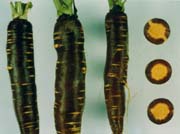| Simon: Pubs: 97hort0146 |

|
Cultivar & Germplasm ReleasesPublished in HortScience 32(1):146-147. 1997 B7262, Purple Carrot InbredAdditional index words. Daucus carota L., vegetable breeding, anthocyanin P.W. Simon1 V.E. Rubatzky2 M.J. Bassett3, J.O. Strandberg4, and J.M. White5 Received for publication 13 Nov. 1995. Accepted for publication 26 May 1997. 1Research Geneticist and Professor. |

Purple roots of carrot inbred B7262.
Purple umbels of carrot inbred B7262 petaloid male sterile. |
The first records of carrot (Daucus carota L.) cultivation date back to the 10th century when production of purple and yellow-rooted types were noted in Iran and northern Arabia (Banga, 1957). For the next 600 years carrot cultivation spread eastward to India, China, and Japan, and westward throughout the Middle East, Northern Africa, and eventually to Northern Europe. Earlier in this period, purple-rooted carrots were considered to have superior culinary quality. As carrots became popular in Northern Europe during the 1400s yellow-rooted types became preferred for reasons which remain unclear. It was not until the 1600s that the now familiar orange root color was selected by early carrot breeders (probably gardeners) in Northern Europe from yellow-rooted types.
Some production of purple-rooted carrots exists today in the Middle East and Asia for specialized uses such as confections and seasonal dishes. B7262 was developed to re-introduce this old characteristic for modern production.
Origin
B7262 was derived from a cross made in 1983 at the University of Wisconsin between plant a derived from PI 173687 (a Turkish accession highly variable for root color and shape) and B10138 (a dark orange Danvers-shaped inbred developed from Danvers 126) (Fig. 1). The PI 173687 derivative which was crossed to B10138, originated from an S3 population (third generation of consecutive self-pollinations) and had purple (anthocyanin) root color in the phloem with a yellow xylem (core). Roots were grown on muck soil at Kincaid Farms in Palmyra, Wisconsin. Seed was produced in Madison, Wisconsin, in the greenhouse or field after 6-8 weeks vernalization of selected roots. (Peterson and Simon, 1986).
Beginning at the F2 generation, selection was made for deep purple outer phloem with dark orange core, cambium, and inner phloem color; for long, blunt, smooth root shape with small core size (3-7mm); and for ample seed production (2-7g per plant). Two generations beyond the F2, selection was also initiated for mild, sweet flavor and for reduced tendency to initiate early flowering (plants with floral initiation during root production were not selected for seed production; Peterson and Simon, 1986). In the F3 and F4 generations, several hundred roots were visually evaluated and 16 and 21 roots (respectively) were self-pollinated in each cycle. The best of nine F5 plants self-pollinated in the 1986 winter greenhouse nursery produced seed for field row 70262 in Palmyra, Wisconsin. Mass selection and sib-mating proceeded for 5 more generations. B7262 resulted; it is a maintainer of sterility ("B" line). A petaloid cytosterile counterpart ("A" line) in the Cornell cytoplasm is available at BC5.
Description
Roots of B7262 are medium long (15-19 cm), cylindrical, and slightly tapered with very dark purple outer phloem, orange inner phloem, cambium, and xylem and a small core (see accompanying cover story, this issue). Root surface is rough in some growing conditions, (especially more friable soils). Haulms (tops) of B7262 are fairly tall, vigorous, and medium green, with strong attachment to the root, and some tendency for early bolting. Purple coloration is also evident in leaves (especially early in development), nodes, anthers, and petals.
Carotene content (fresh weight basis, Simon and Wolff, 1987) of mature roots is 100 to 130 mg.kg-1 (compared to 70 to 100 mg.kg-1 for earlier varieties and 120 to 160 mg.kg -1 for modern fresh market varieties). Flavor of B7262 roots is mild and fairly sweet. B7262 has average resistance to Alternaria leaf blight (causal agent = Alternaria dauci, (Kuhn, Groves, & Skolko)) and is susceptible to powdery mildew. B7262 tends to flower somewhat early (comparable to early-bolting available cultivars for U.S. production) and produces fairly abundant pollen and seed.
Several hybrid combinations with B7262 have been evaluated in Wisconsin, California, and Florida trials (unpublished trial results). Purple root pigmentation is a monogenic dominant trait (Simon, 1996), but penetrance and expressivity varies among hybrids with B7262. Best uniformity for dark purple root color occurs in (B2566 x B7262) and (B9304 x B7262) hybrids. Up to 40% pale purple roots occur in (B7322 x B7262) and (B4367 x B7262) hybrids. Commercial development of purple-rooted carrot hybrids may require several purple-rooted inbred components for uniform expression of this trait. As purple root color is a novelty for modern carrot consumers, commercial acceptance remains to be tested. The purple flower color may also be applicable for ornamental use, especially since the petaloid sterile has a double whorl of persistent petals (see accompanying cover story).
Availability
Inquiry regarding seed availability for carrot inbred B7262 should be directed to P.W.S. It is requested that appropriate recognition be made if this germplasm contributes to the development of a new breeding line or variety. Genetic material of this release is deposited in the National Plant Germplasm System where it is available for research purposes, including development and commercialization of new cultivars.
Literature Cited
Banga, O. 1957. Origin and distribution of the European cultivated carrot. Euphytica 6:54-63.
Peterson, C.E. and P.W. Simon. 1986. Carrot breeding, p.321-356. In: M.J. Bassett (ed.). Breeding vegetable crops. AVI Pub. Co., Westport, CT
Simon, P.W. 1996. Inheritance and expression of purple and yellow storage root color in carrot. J. Hered. 87:63-66.
Simon, P.W. and X.Y. Wolff. 1987. Carotenes in typical and dark orange carrots. J. Agric. Food Chem. 35:1017-1022.
Figure 1. Origin of purple carrot inbred, B7262.

